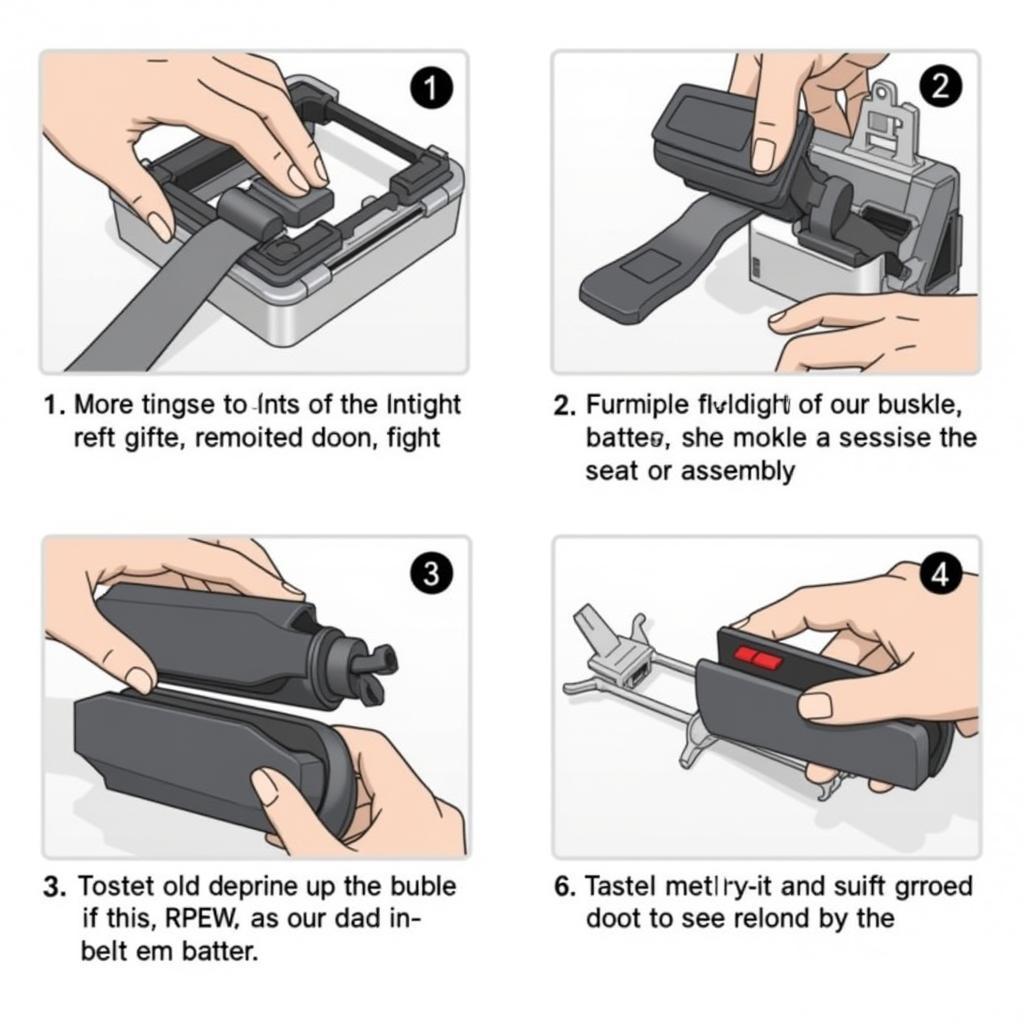The E60 BMW is a marvel of engineering, but even the most sophisticated machines can throw a curveball. One common issue that E60 owners face is the dreaded seat belt warning light, often accompanied by an annoying chime. This issue, while frustrating, can usually be resolved by understanding and addressing the underlying “e60 seat belt warning coding.” This comprehensive guide delves into the intricacies of this problem, providing practical solutions and expert insights to help you get back on the road with peace of mind.
Decoding the E60 Seat Belt Warning System
Your E60 is equipped with a Seat Belt Reminder System (SBRS) designed to enhance safety by encouraging seat belt use. The system comprises several components:
- Seat Occupancy Sensor (SOS): Located in the passenger seat, this sensor detects the presence of a passenger and differentiates between an adult, child, or a child seat.
- Buckle Switch: A simple switch within the seat belt buckle assembly signals whether the belt is fastened or not.
- Warning Light and Chime: When the system detects an unbuckled belt while the vehicle is in motion, it triggers visual (warning light on the dashboard) and auditory (chime) alerts.
 E60 Seat Belt Warning Light Dashboard
E60 Seat Belt Warning Light Dashboard
Common Causes of E60 Seat Belt Warning Coding Errors
Several factors can disrupt the harmony of your E60’s SBRS, leading to persistent warning messages:
- Faulty Seat Occupancy Sensor (SOS): A malfunctioning SOS can send incorrect signals to the system, making it believe a passenger is present when there isn’t, or vice-versa. This scenario often leads to the seat belt warning light staying on even when the seat is empty.
- Defective Buckle Switch: A worn-out or damaged buckle switch might fail to register a fastened seat belt, triggering the warning system.
- Wiring Issues: Loose, corroded, or damaged wiring within the SBRS circuit can disrupt signal transmission, causing erratic behavior.
- Software Glitches: Like any computer system, the E60’s onboard computer can experience software hiccups that affect the SBRS.
Diagnosing the Problem: A Step-by-Step Approach
Before jumping into solutions, it’s crucial to pinpoint the root cause of your E60 seat belt warning coding issue. Here’s a systematic approach:
- Check the Obvious: Start by ensuring all seat belts are properly fastened. Sometimes, the simplest solutions are the most effective.
- Inspect the Buckle Switches: Visually examine the buckle assemblies for any signs of damage or wear. Pay close attention to the release button and the area where the buckle latches.
- Listen for the Chime: The chime’s pattern can provide clues. A continuous chime often points to a buckle switch issue, while an intermittent chime might suggest a problem with the SOS.
- Utilize a Diagnostic Scanner: For a more in-depth analysis, connect a BMW-compatible diagnostic scanner to the vehicle’s OBD-II port. This tool can read fault codes stored in the system, providing valuable insights into the problem’s origin.
 Diagnostic Scanner Connected to BMW E60
Diagnostic Scanner Connected to BMW E60
Addressing E60 Seat Belt Warning Coding Errors
Once you’ve identified the culprit behind your E60 seat belt warning woes, it’s time to implement the appropriate solution:
1. Resetting the System
Sometimes, a simple reset can resolve minor software glitches. Here’s how:
- Disconnect the Battery: Locate the negative terminal of your E60’s battery and disconnect it. Wait for at least 15 minutes to allow the system to fully discharge.
- Reconnect the Battery: Reconnect the negative terminal, ensuring a secure connection.
- Test the System: Turn on the ignition and check if the warning light has been extinguished.
2. Replacing a Faulty Buckle Switch
If you suspect a defective buckle switch, replacement is often the most reliable solution. This process typically involves:
- Gathering Supplies: You’ll need a replacement buckle switch compatible with your E60’s model year and a basic set of tools.
- Accessing the Buckle Assembly: Locate the faulty buckle switch and disconnect its electrical connector.
- Removing the Old Switch: Carefully detach the old switch from its mounting points. This usually involves unscrewing a few bolts or releasing clips.
- Installing the New Switch: Secure the new buckle switch in place and reconnect its electrical connector.
- Testing Functionality: Fasten and unfasten the seat belt several times to ensure the new switch is working correctly.
“Always prioritize using genuine BMW parts or high-quality aftermarket alternatives to ensure compatibility and longevity.” – Mark Stevenson, Lead Technician at Bavarian Autohaus
 Replacing a Seat Belt Buckle in a BMW E60
Replacing a Seat Belt Buckle in a BMW E60
3. Addressing a Malfunctioning Seat Occupancy Sensor (SOS)
Dealing with a faulty SOS can be more complex, often requiring specialized tools and knowledge. If you’re not comfortable tackling this repair yourself, it’s best to seek assistance from a qualified BMW technician.
4. Software Updates and Coding
In some cases, the issue might stem from outdated software or coding errors within the E60’s onboard computer. A software update or reprogramming can rectify these issues. This procedure usually necessitates the expertise of a BMW dealership or a specialized automotive electronics technician.
Preventing Future E60 Seat Belt Warning Coding Issues
While some issues are unavoidable, proactive measures can minimize the risk of encountering e60 seat belt warning coding problems in the future:
- Regular Vehicle Maintenance: Adhering to your E60’s recommended maintenance schedule can help identify and address potential issues before they escalate.
- Gentle Handling of Seat Belts: Avoid slamming the doors with the seat belts extended and refrain from placing heavy objects on the seats, as these actions can put stress on the buckles and wiring.
- Promptly Addressing Warning Lights: If the seat belt warning light illuminates, don’t ignore it. Investigate the issue and have it resolved promptly to prevent further complications.
Conclusion
The E60 seat belt warning coding system, while designed with safety in mind, can sometimes present frustrating challenges. By understanding the intricacies of this system, recognizing common causes of errors, and following the troubleshooting steps outlined in this guide, you can effectively address these issues and restore the peace of mind that comes with driving a well-maintained BMW E60. Remember, if you encounter complex problems or lack the confidence to tackle repairs yourself, seeking professional help from a qualified BMW technician is always a wise decision.

